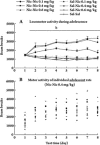Individual differences in responses to nicotine: tracking changes from adolescence to adulthood
- PMID: 19498426
- PMCID: PMC2916677
- DOI: 10.1038/aps.2009.55
Individual differences in responses to nicotine: tracking changes from adolescence to adulthood
Abstract
Aim: The present study determined the extent to which individual differences in responses to the psychostimulating effect of nicotine during adolescence predict similar individual differences during adulthood in rats. We also examined the possible long-term effects of adolescent nicotine exposure on adult prepulse inhibition (PPI) of the acoustic startle response, a measure of sensorimotor gating ability.
Methods: During the adolescent phase, rats were administered saline, 0.10, 0.40, or 0.60 mg/kg nicotine via subcutaneous injections for 8 days, and motor activity was measured daily. During the adult phase, these rats were treated with the same nicotine dose as in adolescence for 8 additional days. The adolescent saline rats (now adults) were subdivided into four groups and administered saline, 0.10, 0.40, or 0.60 mg/kg nicotine, respectively. PPI was assessed 12 days after the last nicotine treatment.
Results: During both phases, nicotine increased motor activity across test days in a dose-dependent manner. Motor activity of rats treated with nicotine during adolescence was positively correlated with the activity recorded from the same rats during adulthood. In both phases, there were profound individual differences in the responses to the nicotine treatments. In addition, adolescent rats treated with nicotine did not show decreased motor response to the initial exposure to nicotine. Finally, adolescent exposure to nicotine at 0.4 mg/kg, but not adulthood exposure to the same dose of nicotine, produced a robust disruption of PPI, with individual rats showing different degrees of PPI disruption.
Conclusion: These findings suggest that adolescent rats have increased sensitivity to the psychostimulating effect and decreased sensitivity to the aversive effect of nicotine. Also, nicotine exposure during adolescence may have long-term detrimental effects on sensorimotor gating ability.
Figures





Similar articles
-
Prenatal IV nicotine exposure produces a sex difference in sensorimotor gating of the auditory startle reflex in adult rats.Int J Dev Neurosci. 2011 Apr;29(2):153-61. doi: 10.1016/j.ijdevneu.2010.12.001. Epub 2010 Dec 8. Int J Dev Neurosci. 2011. PMID: 21145386 Free PMC article.
-
Effects of nicotine on quinpirole- and dizocilpine (MK-801)-induced sensorimotor gating impairments in rats.Psychopharmacology (Berl). 2008 Oct;200(3):403-11. doi: 10.1007/s00213-008-1220-x. Epub 2008 Jul 9. Psychopharmacology (Berl). 2008. PMID: 18607572
-
Varenicline disrupts prepulse inhibition only in high-inhibitory rats.Prog Neuropsychopharmacol Biol Psychiatry. 2014 Aug 4;53:54-60. doi: 10.1016/j.pnpbp.2014.03.001. Epub 2014 Mar 13. Prog Neuropsychopharmacol Biol Psychiatry. 2014. PMID: 24632394
-
Predator odor exposure in early adolescence influences the effects of the bacterial product, propionic acid, on anxiety, sensorimotor gating, and acoustic startle response in male rats in later adolescence and adulthood.Physiol Behav. 2019 Feb 1;199:35-46. doi: 10.1016/j.physbeh.2018.11.003. Epub 2018 Nov 5. Physiol Behav. 2019. PMID: 30408471
-
Adolescent and adult female rats differ in sensitivity to nicotine's activity effects.Pharmacol Biochem Behav. 2005 Apr;80(4):567-75. doi: 10.1016/j.pbb.2005.01.019. Pharmacol Biochem Behav. 2005. PMID: 15820526
Cited by
-
Startle reactivity and prepulse inhibition in prodromal and early psychosis: effects of age, antipsychotics, tobacco and cannabis in a vulnerable population.Psychiatry Res. 2011 Jul 30;188(2):208-16. doi: 10.1016/j.psychres.2011.04.011. Epub 2011 May 8. Psychiatry Res. 2011. PMID: 21555157 Free PMC article.
-
Nicotine: alcohol reward interactions.Neurochem Res. 2010 Aug;35(8):1248-58. doi: 10.1007/s11064-010-0181-8. Epub 2010 May 25. Neurochem Res. 2010. PMID: 20499168 Review.
-
CDP-choline and galantamine, a personalized α7 nicotinic acetylcholine receptor targeted treatment for the modulation of speech MMN indexed deviance detection in healthy volunteers: a pilot study.Psychopharmacology (Berl). 2020 Dec;237(12):3665-3687. doi: 10.1007/s00213-020-05646-1. Epub 2020 Aug 27. Psychopharmacology (Berl). 2020. PMID: 32851421 Clinical Trial.
-
An α7 nAChR approach for the baseline-dependent modulation of deviance detection in schizophrenia: A pilot study assessing the combined effect of CDP-choline and galantamine.J Psychopharmacol. 2023 Apr;37(4):381-395. doi: 10.1177/02698811231158903. Epub 2023 Mar 16. J Psychopharmacol. 2023. PMID: 36927273 Free PMC article. Clinical Trial.
-
Iptakalim Preferentially Decreases Nicotine-induced Hyperlocomotion in Phencyclidine-sensitized Rats: A Potential Dual Action against Nicotine Addiction and Psychosis.Clin Psychopharmacol Neurosci. 2012 Dec;10(3):168-79. doi: 10.9758/cpn.2012.10.3.168. Epub 2012 Dec 20. Clin Psychopharmacol Neurosci. 2012. PMID: 23430396 Free PMC article.
References
-
- Barron S, White A, Swartzwelder HS, Bell RL, Rodd ZA, Slawecki CJ, et al. Adolescent vulnerabilities to chronic alcohol or nicotine exposure: findings from rodent models. Alcohol Clin Exp Res. 2005;29:1720–5. - PubMed
-
- Chen J, Millar WJ.Age of smoking initiation: implications for quitting Health Rep 1998939–46.(Eng); 39–48.(Fre). - PubMed
-
- Chen H, Matta SG, Sharp BM. Acquisition of nicotine self-administration in adolescent rats given prolonged access to the drug. Neuropsychopharmacology. 2007;32:700–9. - PubMed
Publication types
MeSH terms
Substances
Grants and funding
LinkOut - more resources
Full Text Sources

